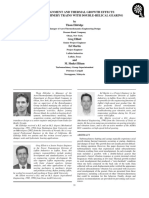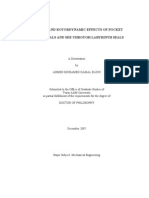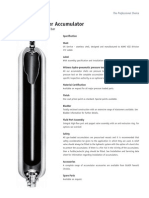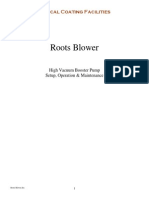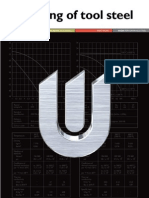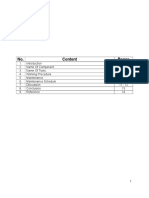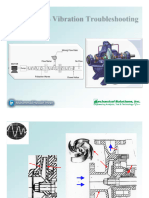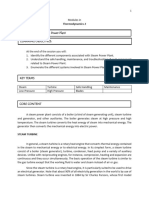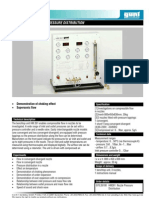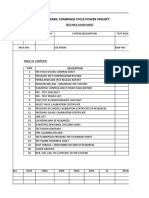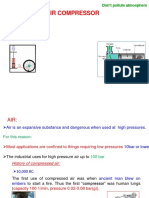Westinghouse Manual Book
Westinghouse Manual Book
Uploaded by
Geraldo CiuffiCopyright:
Available Formats
Westinghouse Manual Book
Westinghouse Manual Book
Uploaded by
Geraldo CiuffiCopyright
Available Formats
Share this document
Did you find this document useful?
Is this content inappropriate?
Copyright:
Available Formats
Westinghouse Manual Book
Westinghouse Manual Book
Uploaded by
Geraldo CiuffiCopyright:
Available Formats
Westinghouse Technology Systems Manual
Section 7.4
General Electric Turbine and Auxiliaries
TABLE OF CONTENTS
7.4 GENERAL ELECTRIC TURBINE AND AUXILIARIES.................................... 7.4-1
7.4.1 Introduction .......................................................................................... 7.4-1
7.4.2 Main Turbine ........................................................................................ 7.4-1
7.4.2.1 System Description ................................................................. 7.4-1
7.4.2.2 Component Descriptions ........................................................ 7.4-2
7.4.3 Gland Steam System ........................................................................... 7.4-4
7.4.3.1 System Description ................................................................. 7.4-4
7.4.3.2 Component Descriptions ........................................................ 7.4-5
7.4.3.3 System Operation ................................................................... 7.4-6
7.4.4 Turbine Lubricating Oil System ............................................................ 7.4-6
7.4.4.1 System Description ................................................................. 7.4-6
7.4.4.2 Component Descriptions ........................................................ 7.4-7
7.4.4.3 System Operation ................................................................. 7.4-10
7.4.5 Moisture Separator Reheaters ........................................................... 7.4-11
7.4.5.1 System Description ............................................................... 7.4-11
7.4.5.2 Component Descriptions ...................................................... 7.4-11
7.4.5.3 System Operation ................................................................. 7.4-12
7.4.6 Summary............................................................................................ 7.4-13
LIST OF FIGURES
7.4-1 ................................................................................. Main Turbine Cross Section
7.4-2 .................................................................... Main Steam System - Low Pressure
7.4-3 ............................................................................................................ Stop Valve
7.4-4 ....................................................................................................... Control Valve
7.4-5 .............................................................................. Combined Intermediate Valve
7.4-6 ........................................................................................... Gland Steam System
7.4-7 .................................................................................................... Turbine Glands
7.4-8 ............................................................................ Turbine Lubricating Oil System
7.4-9 ............................................................ Moisture Separator Reheater (End View)
USNRC HRTD 7.4-i Rev 0803
7.4 GENERAL ELECTRIC TURBINE AND AUXILIARIES
Learning Objectives:
1. State the purposes of the turbine and turbine auxiliaries.
2. Identify the sources of heating steam to the moisture separator reheaters
(MSRs).
3. State the purposes of the following turbine valves:
a. Stop valves,
b. Control valves, and
c. Combined intermediate valves.
7.4.1 Introduction
The purposes of the turbine and auxiliaries are as follows:
1. To convert the thermal energy of the steam to mechanical energy to turn the
main generator,
2. To provide turbine shaft sealing,
3. To provide turbine-generator lubricating oil, and
4. To provide dry, superheated steam to the low pressure turbines to reduce
moisture erosion and to increase plant efficiency.
7.4.2 Main Turbine
7.4.2.1 System Description
The main turbine consists of one high pressure turbine and three low pressure
turbines coupled to a single shaft. The four turbines that comprise the main turbine
are coupled to the generator and exciter; they serve as the prime mover for these
components. A cross-section of the turbine is shown in Figure 7.4-1. Steam enters
the main turbine at the high pressure turbine through the turbine stop (throttle) and
control (governor) valves.
The thermal energy of the steam is converted to mechanical energy in the high
pressure turbine, and the steam is exhausted to the moisture separator reheaters.
In each MSR the steam is dried, reheated, and superheated prior to its entry into the
low pressure turbines. The superheated steam is routed through the intermediate
stop and intercept valves as it travels from the MSRs to the low pressure turbines.
Energy conversion occurs again in the low pressure turbines as the steam expands
into the vacuum of the main condenser.
USNRC HRTD 7.4-1 Rev 0803
7.4.2.2 Component Descriptions
High Pressure Turbine
The high pressure turbine is a double-flow turbine with six stages in each direction.
The first three stages are rateau (impulse) stages, and the last three stages are
reaction stages. Steam enters the four nozzle block segments at the center of the
high pressure turbine and flows axially in both directions. About one fifth of the
steam entering the turbine at 100% power is extracted from the second and fourth
stages for moisture removal, feedwater heating, and reheating of the high pressure
turbine exhaust steam. Most of the steam supplied to the turbine does work in all
six stages and exhausts through six cold reheat (cross-around) lines to the two
MSRs, as shown in Figure 7.4-2.
The turbine rotor assembly, which consists of the rotor and the turbine wheels (the
wheels contain the rotating blades), is machined from a single casting. The rotating
blades (buckets) are secured to the wheels with dovetail joints. The turbine rotor is
supported by two elliptical journal bearings, which carry the rotor’s weight and limit
its radial motion.
Stop Valves
The four stop valves supply steam to the main turbine and close rapidly to isolate
the steam flow to the high pressure turbine when the turbine trips. The stop valves
are located just upstream of the control valves. The stop valve casings are welded
to the control valve casings, and all four casing units are welded together to form a
single assembly. The below-seat chambers of the stop valves are cross-connected,
as are the steam headers upstream of the stop valves; this arrangement allows the
opening of one stop valve to equalize the pressure across all four valve disks.
The stop valves are identical 28-in., reverse-seating globe valves, with the exception
that the #2 stop valve contains an internal bypass valve (see Figure 7.4-3). Opening
the internal bypass valve accounts for a small amount of valve stem movement for
this valve. When opened, the bypass valve uncovers holes in the main valve disk,
allowing steam to flow from the inlet to the outlet with the main disk seated.
Opening the internal bypass valve in the #2 stop valve equalizes the pressure
across the stop valve main disks to allow valve opening (a stop valve’s hydraulic
operator cannot open the valve with a differential pressure of greater than 150 psi
across the main disk). The bypass valve is also used to provide warming steam for
the turbine steam chests and the high pressure turbine shell during turbine startups
(see Chapter 11 .5).
The #2 stop valve position is controlled by the electrohydraulic control (EHC)
system. The other three stop valves are Aslaved@ to the #2 stop valve through a limit
switch associated with the #2 stop valve. (See Chapter 11.5 for details on stop
valve control.)
USNRC HRTD 7.4-2 Rev 0803
Control Valves
The four control valves, located immediately downstream of the stop valves, are
positioned by the EHC system for the control of turbine speed and load (see
Chapter 11.5). Rapid closure of the control valves when the turbine trips provides
redundant isolation of the steam flow to the high pressure turbine. The control
valves admit steam to the high pressure turbine via four internal nozzle block
segments at the center of the turbine rotor.
Each of the control valves is a 28-in., spherically seated globe valve (see Figure 7.4-
4). Each valve contains a small internal pilot valve within the main valve disk.
When a control valve is opened, the first portion of stem movement opens the pilot
valve, thereby reducing the differential pressure across the main valve disk and
reducing the opening force required of the valve’s hydraulic operator. Further stem
movement causes the pilot valve to engage the main disk and open the valve.
Low Pressure Turbines
Each of the three low pressure turbines is a double-flow, condensing turbine with
seven reaction stages in each direction. The MSRs supply steam via the combined
intermediate valves to the center of each turbine; the steam then flows axially in
both directions. About one fourth of the steam entering each low pressure turbine at
100% power is extracted from the seventh, eighth, tenth, and eleventh stages for
moisture removal and feedwater heating (the low pressure turbine stages are
numbered 7 - 13). Most of the steam supplied to each turbine does work in all
seven stages and exhausts to the main condenser.
The rotor of each low pressure turbine is machined from a single forging. The
turbine wheels are manufactured separately and shrunk onto the rotor. The rotating
blades are attached to the wheels with dovetail joints. Due to the steam expansion
that occurs in the low pressure turbine, the blade height and stage diameter
increase with each succeeding stage. The last-stage blading of each low pressure
turbine is 38 in. long. Each low pressure turbine is supported by two journal
bearings.
Combined Intermediate Valves
Each of the six combined intermediate valves consists of two valves in one body,
the intercept valve and the intermediate stop valve. Refer to Figure 7.4-5. The two
valves share the same seating surface but are equipped with separate operators.
The intercept valves and intermediate stop valves are completely open during
normal operation. All 12 valves shut when the turbine trips to provide redundant
isolation of the low pressure turbines from the reheat steam supply. The intercept
valves can also shut partially or completely to limit turbine overspeed following a
load rejection. Intercept valves #1, #2, and #3 are controlled by the EHC system;
intercept valves #4, #5, and #6 are slaved to the controlled intercept valves through
limit switches associated with the controlled valves. The intermediate stop valves
are automatically opened when the master trip reset pushbutton is depressed. (See
Chapter11.5 for a discussion of valve operation.)
USNRC HRTD 7.4-3 Rev 0803
Each intercept valve disk is hollow and cylindrically shaped to accommodate the
disk of its associated intermediate stop valve. This arrangement permits the
intermediate stop valve to open or close with the intercept valve completely closed.
Equalizing holes in the intercept valve disk minimize the differential pressure across
the disk and allow opening of the intercept valve even against maximum reheat
steam pressure. Each intermediate stop valve can be opened with a differential
pressure across the seat of no greater than 150 psi. The intermediate stop valves
are thus opened during the turbine startup sequence before all other turbine valves
are opened so that the differential pressure across the valve seats is minimized.
7.4.3 Gland Steam System
7.4.3.1 System Description
During plant operation the entry of air into and the exit of steam from the main
turbine must be prevented at those points where the rotor penetrates the turbine
casings. These functions are accomplished through the labyrinth design of the
rotor/casing penetrations (glands) and through the operation of the gland steam
system. The system is designed to handle the steam and air flows that would exist
with twice the normal turbine penetration clearances.
The gland steam system (Figure 7.4-6) supplies steam to the turbine glands of the
high and low pressure turbines and of the main feed pump turbines. During startup
and low-load operation, the sealing steam distribution header has two sources of
steam supply: the startup boiler and the main steam system. A regulating valve
controls the steam pressure supplied by either source. In the initial phases of a
startup from cold shutdown conditions, gland steam is supplied from the startup
boiler. Once the plant has been heated up and an adequate supply of main steam
is available, gland steam is supplied from the main steam system. The sealing
steam distribution header also receives low pressure stem leakage from the high
pressure turbine stop and control valves.
At higher plant powers (greater than approximately 40%), the direction of steam flow
in portions of the gland steam system changes. Steam from inside the high
pressure turbine casing leaks past the inner turbine glands and into the sealing
steam distribution header. Similarly, steam leaks from the main feed pump turbine
glands to the distribution header (although at a much smaller flow rate). The steam
leakage from these sources supplies the sealing steam for the low pressure turbine
glands at high powers. The unloading valves on the distribution header relieve any
excess steam pressure during this mode of operation. (Note: The arrows in Figure
7.4-6 indicate the two possible flow directions in certain portions of the system.)
Steam leakage from the inner turbine packing and air leakage through the outer
turbine packing (see Figure 7.4-7) is extracted from the turbine glands by the steam
packing exhauster. The exhauster condenses the incoming steam and returns the
condensate to the main condenser via a drain tank. The exhauster blower
maintains a slight vacuum in the exhauster and discharges air and other
noncondensible gases to the turbine building roof.
USNRC HRTD 7.4-4 Rev 0803
7.4.3.2 Component Descriptions
Gland Seal Regulating Valve
The gland seal regulating valve (CV-3588 in Figure 7.4-6) is a four-in., air-operated
gate valve. The valve’s position is controlled by a pressure controller, which
supplies instrument air to the valve’s operator based on the pressure sensed in the
sealing steam distribution header. The pressure controller maintains the gland
steam supply pressure between 2.5 and 4.5 psig. Control of the distribution header
pressure by the regulating valve is expected only with turbine loads less than 40%.
If the regulating valve or its associated controller is inoperable, the operator can
maintain the gland steam supply pressure with the regulating valve bypass valve
(MO-3586), which is controlled with a control room switch.
Unloading Valves
The two unloading valves are eight-in., direct-acting backpressure regulating valves.
Pressure from the regulating valve controller’s sensing line acts against spring force
in each unloading valve’s operator. The unloading valves are set to crack open with
a gland steam pressure of 3.5 psig and to open fully with a pressure of 5.5 psig. At
loads greater than 40%, the unloading valves are open to relieve excess steam
leakage from the high pressure turbine glands to the main condenser. The normal
steam flow through the unloading valves at full power is 19,190 lbm/hr. If the valves
are inoperable, the operator can manually dump steam to the condenser with the
manual unloading valve (MO-3603), which is controlled with a control room switch.
Turbine Glands
The turbine glands contain labyrinth packing, which provide effective seals for the
shaft penetrations. Each labyrinth seal is made up of stationary, spring-backed
packing rings and machined grooves in the turbine rotor (see Figure 7.4-7). The
packing rings hold stationary teeth arranged concentrically, with very small radial
clearances between the teeth and the rotor. The narrow passages between the
stationary packing and the rotor produce a cumulative pressure drop, which
presents a large resistance to steam or air flow in the axial direction. This seal
design minimizes but does not totally eliminate steam outleakage and air inleakage;
the applied sealing steam completely seals the glands.
As shown in Figure 7.4-7, the high pressure turbine is sealed at both ends with three
sets of packing. At low loads, sealing steam from the gland steam distribution
header pressurizes the annulus formed by the inner and middle sets of packing to
prevent air inleakage into the turbine. Sealing steam which leaks past the middle
set of packing, and air which leaks past the outer set, enter the annulus maintained
at a vacuum by the steam packing exhauster. At higher loads, the higher stage
pressures inside the high pressure turbine casing prevent air inleakage. Instead,
steam leaks past the inner set of packing and flows in the reverse direction to the
gland steam distribution header to serve as the sealing steam supply for the low
pressure turbines. Again, any leakage of steam and/or air past the middle and outer
sets of packing is extracted by the steam packing exhauster.
USNRC HRTD 7.4-5 Rev 0803
Sealing of the low pressure turbines, which exhaust to a vacuum, is always
accomplished in the manner described for the high pressure turbine at low loads.
Steam Packing Exhauster
The steam packing exhauster maintains a vacuum in the outer annuli of the turbine
glands to prevent the escape of steam from the turbines into the turbine building.
The exhauster is a shell-and-tube heat exchanger cooled by the turbine building
cooling water system. The condensed steam is drained from the exhauster to the
main condenser via a loop seal and drain tank. The drain tank level is maintained
by a level control valve in the drain line to the condenser. The slight vacuum in the
exhauster shell is maintained by the exhauster blower.
7.4.3.3 System Operation
During a plant startup, the gland steam system is placed in service before the
turbine startup sequence is initiated. The initial source of steam to the gland steam
system is the startup boiler. As the startup progresses and sufficient main steam
becomes available, the gland steam supply source is transferred to the main steam
system. During normal operation, the gland steam system distribution header
pressure is automatically maintained by the gland seal regulating valve and the
unloading valves. Sealing steam to the turbine glands is maintained during a
shutdown until the condenser vacuum is broken. This practice prevents an inrush of
cold air into the turbine casings, which could result in a bowed rotor. Operation of
the gland steam system is not required during a shutdown after the condenser
vacuum has been broken.
7.4.4 Turbine Lubricating Oil System
7.4.4.1 System Description
The turbine lubricating oil system, illustrated in Figure 7.4-8, supports turbine-
generator operation by supplying lubricating oil to the eight turbine journal bearings,
the thrust bearing, the two generator bearings, the two exciter bearings, and the
turning gear. Under normal operating conditions, the main shaft oil pump, driven by
the turbine shaft, supplies oil to the turbine and generator bearings. The suction
head for the main shaft oil pump is provided by the lubricating oil booster pump,
which takes suction on the lubricating oil reservoir. In addition to supplying the
bearing supply header, the main shaft oil pump also supplies oil to the hydraulic
turbine which drives the lubricating oil booster pump. Return oil from the bearings
gravity drains into the lubricating oil reservoir.
The turbine lubricating oil system includes additional pumps for supplying lubricating
oil when the turbine is not in service: the motor suction pump, the turning gear oil
pump, and the emergency bearing oil pump. The lubricating oil system also
includes bearing lift oil pumps, which supply high pressure oil to turbine and
generator bearings in support of turning gear operation. Detailed descriptions of the
components mentioned here are provided in the following section.
USNRC HRTD 7.4-6 Rev 0803
The system is designed for fire safety. Any pressurized oil supply line which passes
near a hot steam line or potentially hot turbine component is enclosed within an oil
drain line or guard pipe. The drain and guard pipes drain to the lubricating oil
reservoir, ensuring that there is no loss of oil in the event of a supply line rupture.
7.4.4.2 Component Descriptions
Main Shaft Oil Pump
The main shaft oil pump maintains the normal bearing oil pressure under normal
operating conditions. The pump is a single-stage centrifugal pump driven by the
turbine shaft through a step-up gear assembly and is located in the front standard.
The pump suction is supplied with oil at 15 - 20 psig from the electrically driven
motor suction pump during startups and from the lubricating oil booster pump during
normal operation. The main shaft oil pump develops a discharge pressure sufficient
for turbine operation at turbine speeds greater than 1350 rpm. With the turbine at
rated speed, the main shaft oil pump discharges oil at a pressure of 235 psig to the
booster pump turbine and bearing supply header.
Motor Suction Pump
The motor suction pump supplies oil to the suction of the main shaft oil pump when
the turbine speed is less than 1800 rpm. The pump is a single-stage centrifugal
pump driven by a 60-hp ac motor. The pump is located inside the lubricating oil
reservoir, and the motor is mounted atop the reservoir. The pump is started
manually with a control room switch during turbine startups. With the turbine at
rated speed, the pump is idle, and its control switch is in the automatic position. The
motor suction pump starts automatically when the lubricating oil booster pump
discharge pressure falls below 10 psig.
Lubricating Oil Booster Pump
The lubricating oil booster pump supplies the suction head required by the main
shaft oil pump during normal operation. The pump is a single-stage centrifugal
pump driven by the discharge of the main shaft oil pump via a hydraulic turbine.
The lubricating oil pump is located inside the lubricating oil reservoir. Under normal
operating conditions, it supplies a suction pressure of 15 - 20 psig to the main shaft
oil pump. The booster pump turbine exhaust oil is supplied to the bearing supply
header, where it joins the flow supplied directly by the main shaft oil pump.
Turning Gear Oil Pump
Because the main shaft oil pump cannot provide adequate bearing lubrication with
turbine speeds less than 1350 rpm, the turning gear oil pump is provided as the
pumping source of lubricating oil during turbine startups and shutdowns. The pump
is a single-stage centrifugal pump driven by a 50-hp ac motor. The pump is located
inside the lubricating oil reservoir, and the motor is mounted atop the reservoir. The
pump is operated manually during startups and shutdowns. With the turbine at
rated speed, the pump is idle, and its control switch is in the automatic position. The
turning gear oil pump starts automatically when either the bearing supply header
USNRC HRTD 7.4-7 Rev 0803
pressure falls below 15 psig or the main shaft oil pump discharge pressure falls
below 190 psig.
Emergency Bearing Oil Pump
The emergency bearing oil pump supplies lubricating oil to the turbine and generator
bearings for the safe shutdown of the turbine-generator when ac power is not
available. The pump is a single-stage centrifugal pump driven by a 30-hp dc motor.
The pump is located inside the lubricating oil reservoir, and the motor is mounted
atop the reservoir. Under normal operating conditions, the pump is idle, and its
control switch is in the automatic position. The emergency bearing oil pump starts
automatically whenever the turning gear oil pump discharge pressure is less than 10
psig coincident with a main shaft oil pump discharge pressure of less than 180 psig.
Baffler Valves
Two flow regulating valves, called baffler valves, in the lubricating oil system
correctly apportion the main shaft oil pump discharge to the lubricating oil booster
pump turbine and the bearing supply header. The valves are manually adjusted so
that the bearing supply header pressure is maintained at 25 psig and that the
discharge pressure of the lubricating oil booster pump is maintained between 15
and 20 psig.
Lubricating Oil Coolers
Before it is supplied to the turbine bearings, the lubricating oil is cooled in one of the
two lubricating oil coolers. As each is a 100% capacity cooler, only one is in service
at a time. The in-service cooler is determined by the position of the transfer valve.
Cooling water from the turbine building cooling water system flows through the
tubes, and lubricating oil flows through the shell of the in-service cooler. A flow
control valve regulates the cooling water flow to maintain a lubricating oil reservoir
temperature of l20°F.
Lubricating Oil Reservoir
The lubricating oil reservoir stores the return oil from the lubricating oil system and
provides the necessary suction head for each system pump located inside the
reservoir. Oil gravity drains from the turbine and generator bearings and enters the
reservoir through two wire screens arranged in series. The reservoir’s total capacity
is 10,000 gal; the normally maintained oil volume is 7450 gal. The additional
capacity accommodates the volume of oil which returns from the system piping
when the lubricating oil system is shut down. The reservoir level instrumentation
supplies high and low level alarms, with setpoints of " four in. from the normal level
(five ft), and a high-high level alarm, with a setpoint of four in. below the top of the
reservoir. The high-high level alarm warns of a potential overflow.
Vapor Extractor
Air and other vapors are constantly removed from the lubricating oil reservoir by the
vapor extractor. The extractor is a centrifugal blower driven by a 7.5-hp motor. The
USNRC HRTD 7.4-8 Rev 0803
extractor takes suction on the reservoir and discharges through a mist eliminator to
the turbine building roof. Because the vapor extractor maintains a slight vacuum in
the reservoir, it also ventilates the lubricating oil drain lines from the turbine and
generator bearings. Effective ventilation of the system enhances the removal of
some of the contaminating influences that might affect the service life of the
lubricating oil.
Bearing Lift Oil Pumps
The lubricating oil supply lines to bearings #3 through #10 (eight journal bearings
which support the three low pressure turbines and the generator) differ from the
other oil supply lines in that they are provided with bearing lift oil pumps. Operation
of the bearing lift oil pumps reduces the torque on the turning gear motor and
reduces the turning gear teeth stresses. The lift oil pumps serve these purposes by
supplying high pressure oil to the lower halves of the bearings (the underside of the
turbine shaft); the oil actually lifts the turbine shaft. In each bearing supplied by a lift
oil pump, the high pressure oil passes through the lower half of the bearing into a
recessed pocket. The pocket is located in the babbitt surface of the bearing. When
sufficient pressure is built up in all of the bearings, the shaft will lift approximately
two to five mils.
Each of the eight bearing lift oil pumps is a positive displacement pump driven by a
five-hp ac motor. Each of the pumps supplies a single bearing. Upon initial starting,
each pump generates a discharge pressure of 3000 - 3500 psig. As the shaft lifts,
the pressure drops to about 900 psig. Each pump has a filter in its suction line for
the removal of foreign material and a relief valve in its discharge line for
overpressure protection. Pump running indication is provided for each pump by a
pressure switch in its discharge line.
The bearing lift oil pumps can be started manually with control room switches or
automatically through the operation of the low speed switch when the turbine speed
decreases to 1.5 rpm (indicating that turning gear operation is required; refer to the
turning gear description in the following paragraphs). The lift oil pumps are
manually started when the turbine speed decreases to 900 rpm following a turbine
trip. A starting permissive for each pump is supplied by a pressure switch which
senses the pressure in the pump’s suction line; a pump start is permitted when
suction pressure is greater than six psig. Similarly, a running pump will trip if its
suction pressure falls below one psig.
Turning Gear
The function of the turning gear is to prevent turbine shaft distortion when it is being
heated or cooled. Damage to the turbine because of rubbing between the moving
and stationary components is therefore prevented. The turning gear slowly rotates
the shaft when the turbine is shutdown and is being heated or cooled. The slow
rotation ensures an even circumferential temperature distribution around the rotor.
The turning gear is a motor-driven pinion that meshes with a bull gear located on the
turbine shaft between bearings #8 and #9 (i.e., between the last low pressure
USNRC HRTD 7.4-9 Rev 0803
turbine and the generator). The pinion is driven at 900 rpm by a 60-hp, single-speed
motor. The pinion drives the bull gear (and thus the turbine shaft) at 1.5 rpm.
The turning gear can be manually engaged by turning a wrench on the projection of
the shaft engaging mechanism or by depressing a pushbutton at the local turning
gear control panel. The pushbutton energizes a solenoid-operated valve which
applies instrument air pressure to the turning gear engaging mechanism. The air
pressure acts on a piston which, through mechanical linkage, forces the pinion to
mesh with the bull gear. The solenoid-operated valve is also energized (and the
turning gear engagement sequence is initiated) when the turning gear is
automatically engaged by the low speed switch, which actuates when the turbine
speed drops to 1.5 rpm. Automatic engagement of the turning gear or manual
engagement with the local pushbutton is permitted when the turning gear motor is
running.
The turning gear motor is started manually with a local control switch or
automatically by the low speed switch described above. With an automatic start of
the turning gear, there is a time delay between motor starting and gear engagement
to ensure that the turning gear motor starts unloaded. Three permissives must be
satisfied to start the turning gear motor either manually or automatically:
1. At least one bearing lift oil pump is running (as indicated by a pump discharge
pressure of greater than 840 psig),
2. Bearing supply header pressure is greater than 10 psig, and
3. The generator output breakers are open.
In addition, an interlock provided by the speed control unit of the EHC system
prevents automatic starting of the turning gear motor when the turbine speed
exceeds 100 rpm.
7.4.4.3 System Operation
With the plant shutdown, the turning gear oil pump and the bearing lift oil pumps are
running to supply the turbine and generator bearing lubrication requirements and to
support turning gear operation. In preparation for rolling the turbine, the motor
suction pump is started to provide a suction head for the main shaft oil pump. The
emergency bearing oil pump is idle, and its control switch is in automatic.
As the turbine speed increases, the speed of the main shaft lubricating oil pump
increases, and the pump begins to develop a discharge pressure. The main shaft
oil pump provides lubricating oil flow via the baffler valves to the turbine driver for
the lubricating oil booster pump and to the bearing supply header. At low turbine
speeds, the main shaft oil pump does not provide sufficient flow to support turbine
operation; the turning gear oil pump supplies the majority of lubricating oil flow to the
turbine and generator bearings.
When the turbine speed reaches 900 rpm, operation of the bearing lift oil pumps is
no longer necessary, and the pumps are manually stopped. As the turbine speed
approaches 1800 rpm, the discharge pressures of the main shaft oil pump and the
lubricating oil booster pump gradually increase. When the turbine has reached
USNRC HRTD 7.4-10 Rev 0803
rated speed, the discharge pressure of the main shaft lubricating oil pump exceeds
that of the turning gear oil pump, and the main shaft lubricating oil pump supplies all
oil flow to the bearings. Also, the lubricating oil booster pump is now supplying the
suction head to the main shaft lubricating oil pump.
With the turbine at rated speed, the motor suction pump and the turning gear oil
pump are manually stopped to complete the normal operating alignment of the
turbine lubricating oil system. The control switches for these pumps are placed in
automatic. The motor suction pump, the turning gear oil pump, and the emergency
bearing oil pump will automatically start as required by system conditions.
7.4.5 Moisture Separator Reheaters
7.4.5.1 System Description
Two identical moisture separator reheaters convert the Awet@ exhaust steam from
the high pressure turbine into the dry, superheated steam supplied to the low
pressure turbines. MSR B also supplies low pressure steam to the main feed pump
turbines. The exhaust steam entering the MSRs at 370EF and a moisture content of
12% is reheated to an exit temperature of 504EF. In the MSRs the steam is dried by
moisture separators and heated by two stages of reheater tube bundles. The MSRs
improve the plant’s secondary cycle efficiency and minimize moisture-induced
erosion of the low pressure turbine blading.
7.4.5.2 Component Descriptions
MSR Shells and Moisture Separators
Each MSR shell is a cylindrical vessel 74 ft long and 12 ft in diameter. The carbon
steel shell is 1.25 in. thick and has a design pressure of 270 psig. Three relief valves
mounted atop each MSR provide overpressure protection. High pressure turbine
exhaust steam (also called cold reheat steam) enters each shell at the bottom via
three inlet nozzles and exits the top of the shell, having been dried and reheated, via
three outlet nozzles. Each outlet line supplies one low pressure turbine.
In each MSR, the incoming steam encounters impingement baffles at each inlet.
Refer to Figure 7.4-9. The baffles direct the steam flow axially to the primary steam
lanes located in the lower portion of the MSR. From the primary steam lanes the
steam bleeds into the moisture separator panels. The chevron-type moisture
separator panels force the steam to undergo abrupt changes in direction; the dense
moisture droplets are deposited on the chevron plates. The removed moisture
collects at the base of the MSR and drains through six 10-in. penetrations to a
common 24-in. header, which in turn drains to the MSR drain tank (each MSR has
an associated drain tank). The dried steam exiting the moisture separators is
directed upward through the first- and second-stage reheater tube bundles. The
reheated steam exits the top of the MSR via the outlet nozzles.
USNRC HRTD 7.4-11 Rev 0803
First-Stage Reheater Tube Bundles
Each first-stage reheater tube bundle is comprised of 690 stainless steel tubes. The
straight-run sections of the tubes are 58 ft in length, and the tubes are one in. in
diameter. As shown in Figure 7.4-2, the first-stage tube bundles are supplied with
second-stage extraction steam from the high pressure turbine via steam supply
valves MO-3672A (MSR A) and MO-3672B (MSR B). The steam supply valves
have no associated control system; the steam supply to the first-stage reheater tube
bundles increases with extraction steam pressure as the turbine load is increased.
The steam supply valves are opened when the turbine speed has reached 1800 rpm
during plant startups. The condensate formed in the first-stage reheater tube
bundles drains to the first-stage reheater drain tanks (one drain tank per MSR).
Second-Stage Reheater Tube Bundles
The construction of the second-stage reheater tube bundles is identical to that of the
first-stage bundles, except that each second-stage bundle contains 621 tubes. As
shown in Figure 7.4-2, the second-stage reheater tube bundles are supplied with
steam from the main steam system bypass header via steam supply isolation valves
MO-3590A (MSR A) and MO-3590B (MSR B). These valves are open when the
turbine load exceeds 15%. Two parallel valves regulate the steam flow to each
second-stage reheater tube bundle: an air-operated low load control valve (CV-
36l2A for MSR A and CV-3612B for MSR B) and a motor-operated high load valve
(MO-36l3A for MSR A and MO-3613B for MSR B). The condensate formed in the
second-stage reheater tube bundles drains to the second-stage reheater drain tanks
(one drain tank per MSR).
The second-stage reheat control system controls the positions of the parallel valves
in the second-stage reheater supply lines. The control system modulates the
positions of the low load control valves over the turbine load range of 15 - 60%.
The valve positions are varied to maintain the appropriate second-stage reheater
supply pressure for the existing turbine load. The inputs to the controller for each
low load control valve are (1) a signal proportional to the supply header pressure
downstream of the valve and (2) a signal proportional to the shell-side pressure of
MSR B (an indication of turbine load). Any error between these signals results in a
valve position change. The control system automatically opens the high load valves
when the turbine load reaches 60% (as indicated by the MSR B shell-side pressure)
to reduce the pressure drops in the second-stage reheater supply lines for high
turbine loads.
7.4.5.3 System Operation
During a plant startup, the first-stage reheater steam supply valves are manually
opened when the turbine speed has reached 1800 rpm. The steam flow to the first-
stage reheater tube bundles increases as the high pressure turbine extraction steam
pressure increases with turbine load. When the turbine load reaches 15%, the
second-stage reheater steam supply isolation valves are manually opened. For
turbine loads in the range of 15 - 60%, the second-stage reheat control system
controls the main steam supply to the second-stage reheater tube bundles via the
low load control valves. When the turbine load exceeds 60%, the operator verifies
USNRC HRTD 7.4-12 Rev 0803
that the control system has opened the high load valves which supply the second-
stage reheaters.
During a plant shutdown, the operator verifies that the high load valves close when
the turbine load has been reduced to less than 60%. The operator manually closes
the second-stage reheater steam supply valves when the turbine load reaches 15%.
Once the turbine has tripped, the operator manually closes the first-stage reheater
supply valves.
7.4.6 Summary
The nuclear steam supply system supplies steam to the main turbine. The main
turbine consists of one high pressure turbine and three low pressure turbines
coupled to the main generator. Hydraulically operated control valves regulate the
flow of steam to the turbines, thereby adjusting the turbine speed in accordance with
operator commands or maintaining a desired electric load for the grid.
Dry, superheated steam is supplied to the low pressure turbines by the moisture
separator reheaters. The MSRs improve secondary cycle efficiency and minimize
low pressure turbine blade erosion. In addition, one of the MSRs supplies steam to
the main feed pump turbines.
The gland steam system is designed to prevent air entry into the turbine or steam
leakage out of the turbine. The turbine lubricating oil system provides all required
lubrication for the turbine and generator bearings.
USNRC HRTD 7.4-13 Rev 0803
You might also like
- Introduction To TurbomachineryDocument1 pageIntroduction To TurbomachineryRAJENDRA PADAMATA0% (2)
- Book ListDocument2 pagesBook ListmukeshkumarjNo ratings yet
- Flatlapping Polishing-Lamplan 2016 Indep-Mdef PDFDocument64 pagesFlatlapping Polishing-Lamplan 2016 Indep-Mdef PDFGowtham VishvakarmaNo ratings yet
- Centrifugal Compressor - Wikipedia, The Free EncyclopediaDocument10 pagesCentrifugal Compressor - Wikipedia, The Free EncyclopediaAmbgAmbg100% (1)
- Steam Turbine-Part III - Trip and Throttle ValveDocument7 pagesSteam Turbine-Part III - Trip and Throttle ValveAahmer Hasan100% (1)
- Axial CompressorsDocument24 pagesAxial CompressorsVamsi MahantiNo ratings yet
- Alloy Reference LibraryDocument1 pageAlloy Reference LibraryDeepakNo ratings yet
- Selection of Materials For Welding-1Document2 pagesSelection of Materials For Welding-1Alex joseph alexNo ratings yet
- Thermojet TechDocument38 pagesThermojet TechLim Dongseop0% (1)
- Radial Turbine Design ProcessDocument15 pagesRadial Turbine Design ProcessKamaldeep GuptaNo ratings yet
- Axial Alignment and Thermal Growth Effects On Turbomachinery Trains With Double-Helical GearingDocument12 pagesAxial Alignment and Thermal Growth Effects On Turbomachinery Trains With Double-Helical GearingAnton HidayatNo ratings yet
- The Design and Analysis of Gas Turbine BladeDocument3 pagesThe Design and Analysis of Gas Turbine Bladeaerobrother100% (4)
- Boletin Tecnico No. 3 Turbinas de Vapor ElliottDocument12 pagesBoletin Tecnico No. 3 Turbinas de Vapor Elliottcristobal_tl227750% (2)
- Rotating Equipment Classifications: By: Eng. Abobakrelsedik MohamedDocument97 pagesRotating Equipment Classifications: By: Eng. Abobakrelsedik Mohamedaalipour967No ratings yet
- KSB WKT: According To API 610 As Per Directive 94/9/ECDocument30 pagesKSB WKT: According To API 610 As Per Directive 94/9/ECBudi SulistiyoNo ratings yet
- C289Document22 pagesC289Gato SesaNo ratings yet
- Leakage and Rotor Dynamic Effects Through Labyrinth SealsDocument221 pagesLeakage and Rotor Dynamic Effects Through Labyrinth SealsMartijn van der Schoot100% (1)
- Ludeca Thoughts On Dowel Pins in Machine FeetDocument4 pagesLudeca Thoughts On Dowel Pins in Machine Feetskaker100% (1)
- DONIT IG Brosura NOVO PDFDocument36 pagesDONIT IG Brosura NOVO PDFMohamed RizkNo ratings yet
- Uk-Standard Asme Bladder AccumulatorDocument3 pagesUk-Standard Asme Bladder AccumulatorRamin SoadNo ratings yet
- Ball BearingDocument70 pagesBall Bearingpatrik710No ratings yet
- Chap 6 Reaction TurbineDocument10 pagesChap 6 Reaction TurbineSourabh SalunkheNo ratings yet
- Mil HDBK 506Document15 pagesMil HDBK 506Jais JohnNo ratings yet
- Roots Blower PDFDocument8 pagesRoots Blower PDFjamjam1062No ratings yet
- Turbine Sealant For Parting Planes - BirkositDocument2 pagesTurbine Sealant For Parting Planes - BirkositProject Sales CorpNo ratings yet
- Bhel Turbine Block 3 PresentationDocument29 pagesBhel Turbine Block 3 Presentationnischal100% (1)
- Welding of Tool SteelDocument15 pagesWelding of Tool SteelRonaldo JuniorNo ratings yet
- Design and Analysis of Steam Turbine Blade Using AnysisDocument3 pagesDesign and Analysis of Steam Turbine Blade Using AnysisNaveenprakashNo ratings yet
- Bolts (Al Rashed Fastners) PDFDocument71 pagesBolts (Al Rashed Fastners) PDFAbuNo ratings yet
- API 682 4th Edition Category 1 Configurations: 3CW-FBDocument19 pagesAPI 682 4th Edition Category 1 Configurations: 3CW-FBtuliofilipeNo ratings yet
- Fact Sheet Til 1292Document2 pagesFact Sheet Til 1292PervimNo ratings yet
- Hydrodynamics Journal BearingDocument14 pagesHydrodynamics Journal BearingAhmad Shayuty75% (4)
- Chapter Four: Steam TurbineDocument23 pagesChapter Four: Steam Turbineserverbek0527No ratings yet
- Electric Drive Vs Gas Turbines: January 2006Document10 pagesElectric Drive Vs Gas Turbines: January 2006Adool FighterNo ratings yet
- Elliott Brush Ring Seals: Installation KitDocument2 pagesElliott Brush Ring Seals: Installation Kitfouzi gher100% (1)
- Advanced Compressor Less Purge ControlsDocument32 pagesAdvanced Compressor Less Purge ControlsMaha BlueNo ratings yet
- James Walker - Chevron - Multi-Lip - Packing - Fitting - Guide PDFDocument2 pagesJames Walker - Chevron - Multi-Lip - Packing - Fitting - Guide PDFHunterNo ratings yet
- Pump Vibration TroubleshootingDocument112 pagesPump Vibration TroubleshootingRavi Kasaudhan (ES)No ratings yet
- API 612 2014 Mechanical Running TestDocument2 pagesAPI 612 2014 Mechanical Running Testşenol LimanNo ratings yet
- Terry TurbineDocument8 pagesTerry TurbinealexmontellNo ratings yet
- Lesson Guide For Periodic InspectionDocument3 pagesLesson Guide For Periodic Inspectionmister pogi100% (1)
- Technologies For High Performance and Reliability of Geothermal Power PlantDocument4 pagesTechnologies For High Performance and Reliability of Geothermal Power Plantsum1else4No ratings yet
- Manual FinalDocument49 pagesManual FinalAmar PandeyNo ratings yet
- ANSALDObrochure Steam Turbines LoDocument8 pagesANSALDObrochure Steam Turbines LoErnesto Sánchez GómezNo ratings yet
- Valves Preventive Maintenance Rotine VPMR - Day3Document40 pagesValves Preventive Maintenance Rotine VPMR - Day3OsamaAlaasam100% (1)
- A Problem With The Gas Turbine Flame Sensor (SPECTRA GT30) - After GT Shut Down It Still Indicating Presence of Flame Until We Reset ItDocument8 pagesA Problem With The Gas Turbine Flame Sensor (SPECTRA GT30) - After GT Shut Down It Still Indicating Presence of Flame Until We Reset ItAbdulyunus AmirNo ratings yet
- Section 9.1.1-6 GER3621Document16 pagesSection 9.1.1-6 GER3621Hiram FloresNo ratings yet
- Glossary of TurbineDocument5 pagesGlossary of TurbinevesselNo ratings yet
- 10b Dodge SleevoilDocument32 pages10b Dodge SleevoilSofiane HalimiNo ratings yet
- Quality-Control RebabbitDocument1 pageQuality-Control RebabbitChandra SimanjuntakNo ratings yet
- FNDSC - MS9001Document59 pagesFNDSC - MS9001shravani mangalpalliNo ratings yet
- ID Fan Dodge BRGDocument4 pagesID Fan Dodge BRGjhanduNo ratings yet
- Steam Turbine Study Emg 32/25: Title: Document Code RevisionDocument23 pagesSteam Turbine Study Emg 32/25: Title: Document Code RevisionUdhayakumar Venkataraman100% (1)
- Off-Design Flow Analysis and Performance Prediction of Axial TurbinesDocument13 pagesOff-Design Flow Analysis and Performance Prediction of Axial TurbinesaliNo ratings yet
- Energy Harvesting Using Mechanical Vibrations A Complete GuideFrom EverandEnergy Harvesting Using Mechanical Vibrations A Complete GuideNo ratings yet
- GT1Document91 pagesGT1Irfan Ullah100% (2)
- Module 3 - Introduction To Steam Cycles (Steam Power Plant)Document14 pagesModule 3 - Introduction To Steam Cycles (Steam Power Plant)MLNDG boysNo ratings yet
- Research Work Week 9Document3 pagesResearch Work Week 9jonas lintagNo ratings yet
- Basic Diesel Engines - Jun-17-1Document124 pagesBasic Diesel Engines - Jun-17-1Moataz NazeemNo ratings yet
- Basic Diesel Engines - Mar-17Document124 pagesBasic Diesel Engines - Mar-17Moataz Abdelkader100% (1)
- D-Depsd: Pressure ControlDocument2 pagesD-Depsd: Pressure ControlIDIRHE ABRAHAMNo ratings yet
- Drilling NotesDocument137 pagesDrilling NotesmohammedNo ratings yet
- Nozzle Pressure Distribution TestDocument1 pageNozzle Pressure Distribution TestsaravananiniafiaNo ratings yet
- Technical Query PSV SizeDocument2 pagesTechnical Query PSV SizeElias EliasNo ratings yet
- IPS Standard PDFDocument44 pagesIPS Standard PDFFathy MostafaNo ratings yet
- I. History: II. Typical Design / Parts / ComponentsDocument16 pagesI. History: II. Typical Design / Parts / ComponentsAriel GamboaNo ratings yet
- Material List PDFDocument231 pagesMaterial List PDFMangleshMishraNo ratings yet
- 2 Stage Compressor Manual ESOLSDocument34 pages2 Stage Compressor Manual ESOLSkghkhanNo ratings yet
- Test PackDocument38 pagesTest PackAbdülHak ÖZkara100% (1)
- Hydraulic/Pneumatic Symbols: For System Diagrams and Component IdentificationDocument54 pagesHydraulic/Pneumatic Symbols: For System Diagrams and Component IdentificationMuhammad Qasim SajidNo ratings yet
- Service Kit Hcr1500-D20/D20 Ii/Ed Ii With Cat C9 EngineDocument3 pagesService Kit Hcr1500-D20/D20 Ii/Ed Ii With Cat C9 EngineMustofa TofaNo ratings yet
- Compressors::: Process EquipmentDocument14 pagesCompressors::: Process EquipmentKaung Htet ChoNo ratings yet
- Mechanical Engineering Department: PPT On Fluid MachineryDocument111 pagesMechanical Engineering Department: PPT On Fluid MachineryPasindu PramodNo ratings yet
- Cylinder Visual Inspection FormDocument2 pagesCylinder Visual Inspection Formzineddine sofieneNo ratings yet
- HPT Blade 3dDocument6 pagesHPT Blade 3dfarazh.oneNo ratings yet
- t6d Denison Vane Pumps IndustrialDocument5 pagest6d Denison Vane Pumps Industrialisrael ruiz gallardoNo ratings yet
- Control Valve SizingDocument6 pagesControl Valve SizingAlfonsus W.M.No ratings yet
- Cross Reference Mann 00005Document1 pageCross Reference Mann 00005GerenciamentoNo ratings yet
- Elmo Rietschle V Series Oil Lubricated Rotary Vane BrochureDocument8 pagesElmo Rietschle V Series Oil Lubricated Rotary Vane Brochuregeorge andreiNo ratings yet
- Print Section 6 Yamatake SFC For DSTJ TransmittersDocument11 pagesPrint Section 6 Yamatake SFC For DSTJ TransmittersaloordominicNo ratings yet
- Hydraulics Handout 1Document112 pagesHydraulics Handout 1Er. Satya Narayan Shah100% (2)
- Tutorial 3 - Flow Measurement - Intro To Rotating Equipm - SolutionsDocument8 pagesTutorial 3 - Flow Measurement - Intro To Rotating Equipm - SolutionsKumaravel PadmaroopaNo ratings yet
- Chercher BOQDocument4 pagesChercher BOQbereketNo ratings yet
- Engine Oil Pressure 330DDocument5 pagesEngine Oil Pressure 330DJebrodNo ratings yet
- Experiment No 08Document4 pagesExperiment No 08Muhammad Zohaib ShahidNo ratings yet
- Gujarat Technological University: W.E.F. AY 2018-19Document3 pagesGujarat Technological University: W.E.F. AY 2018-19suraj nakumNo ratings yet
- Hydraulik-Diagram - Hydraulic-Diagram - Hydraulik-Diagramm Ommelift 2100 Ebz-P 2100 Ebz-DDocument21 pagesHydraulik-Diagram - Hydraulic-Diagram - Hydraulik-Diagramm Ommelift 2100 Ebz-P 2100 Ebz-DStianNo ratings yet
- Air CompressorDocument89 pagesAir Compressorragunath LakshmananNo ratings yet
- Bullseye B70-Spsk: Vacuum Loading Slurry-Solids PumpDocument2 pagesBullseye B70-Spsk: Vacuum Loading Slurry-Solids PumpGuilhermePlacidoNo ratings yet
- 2023 Summer Question Paper (Msbte Study Resources)Document4 pages2023 Summer Question Paper (Msbte Study Resources)Pratham DalviNo ratings yet










